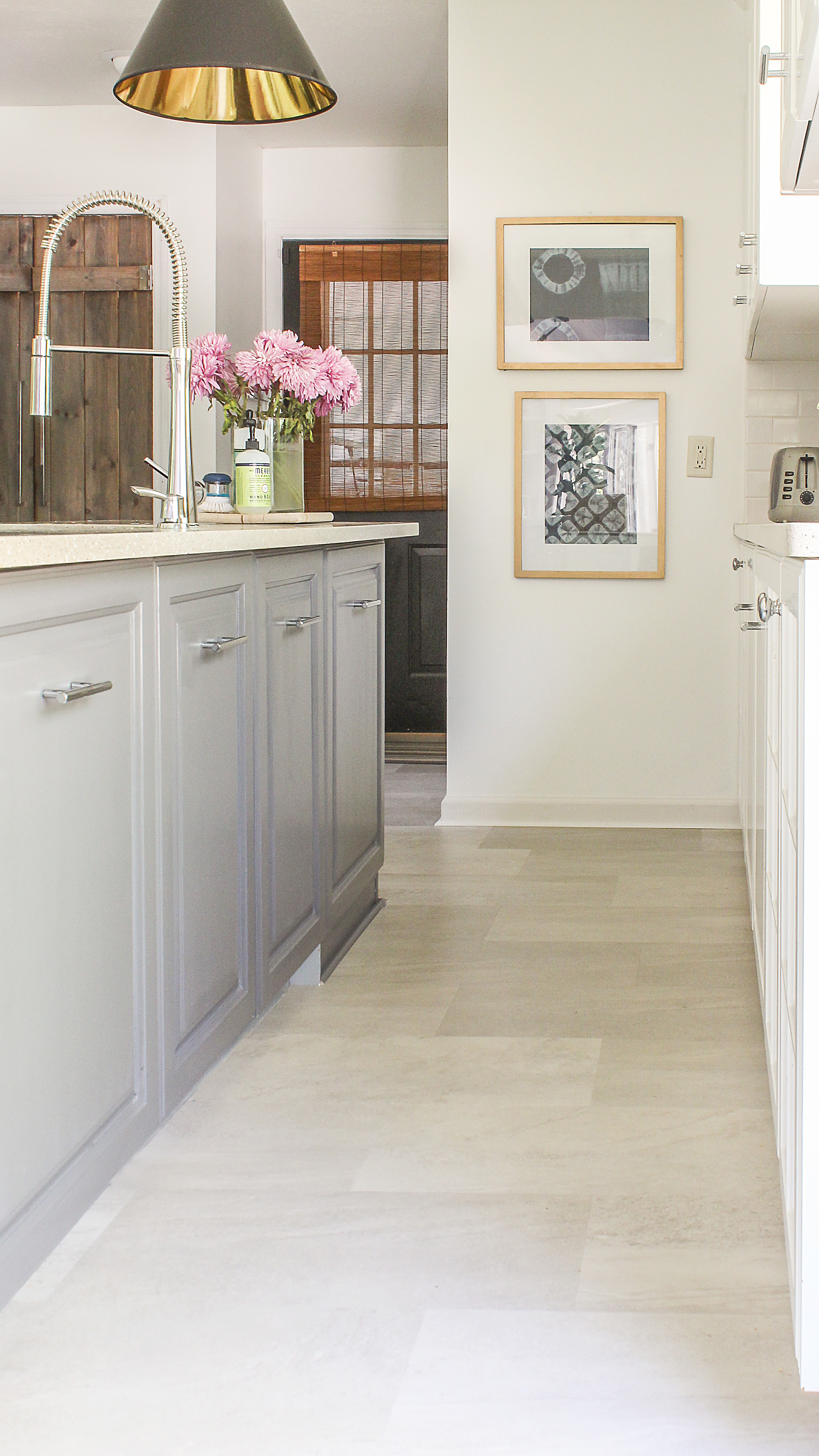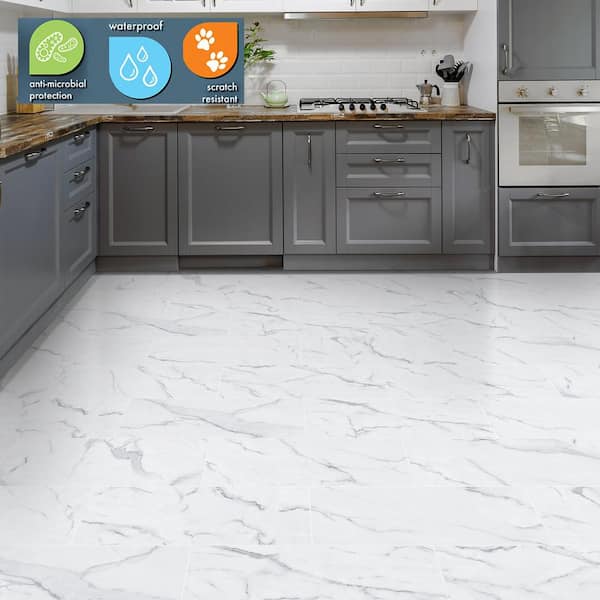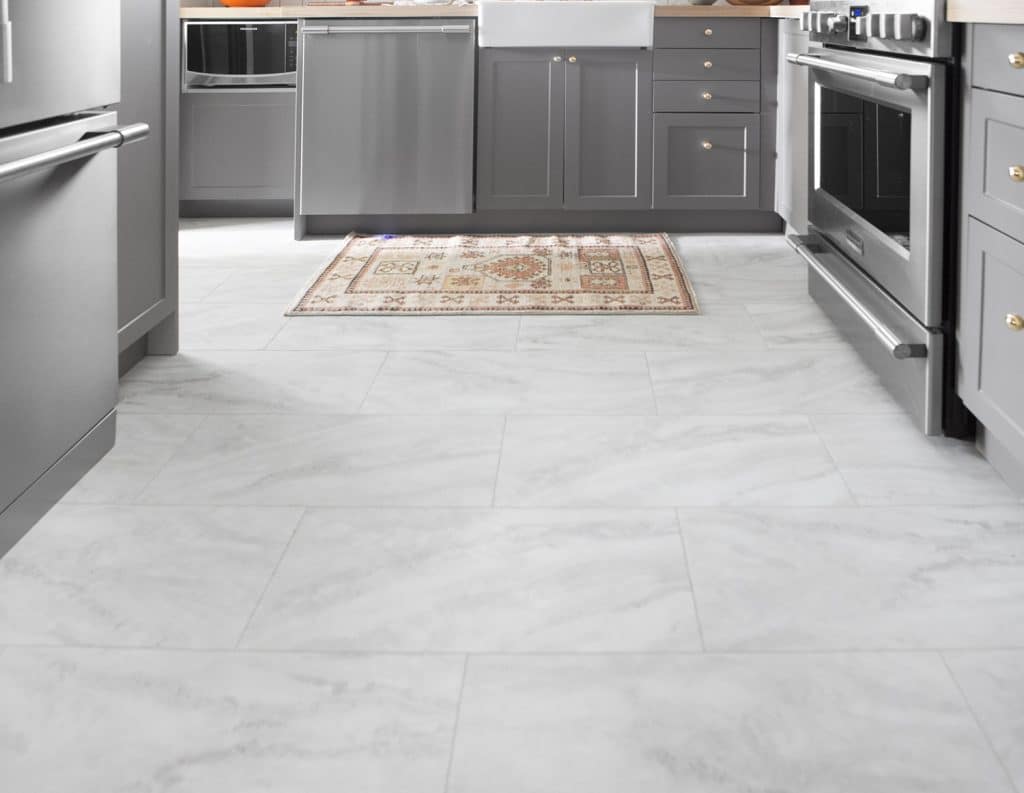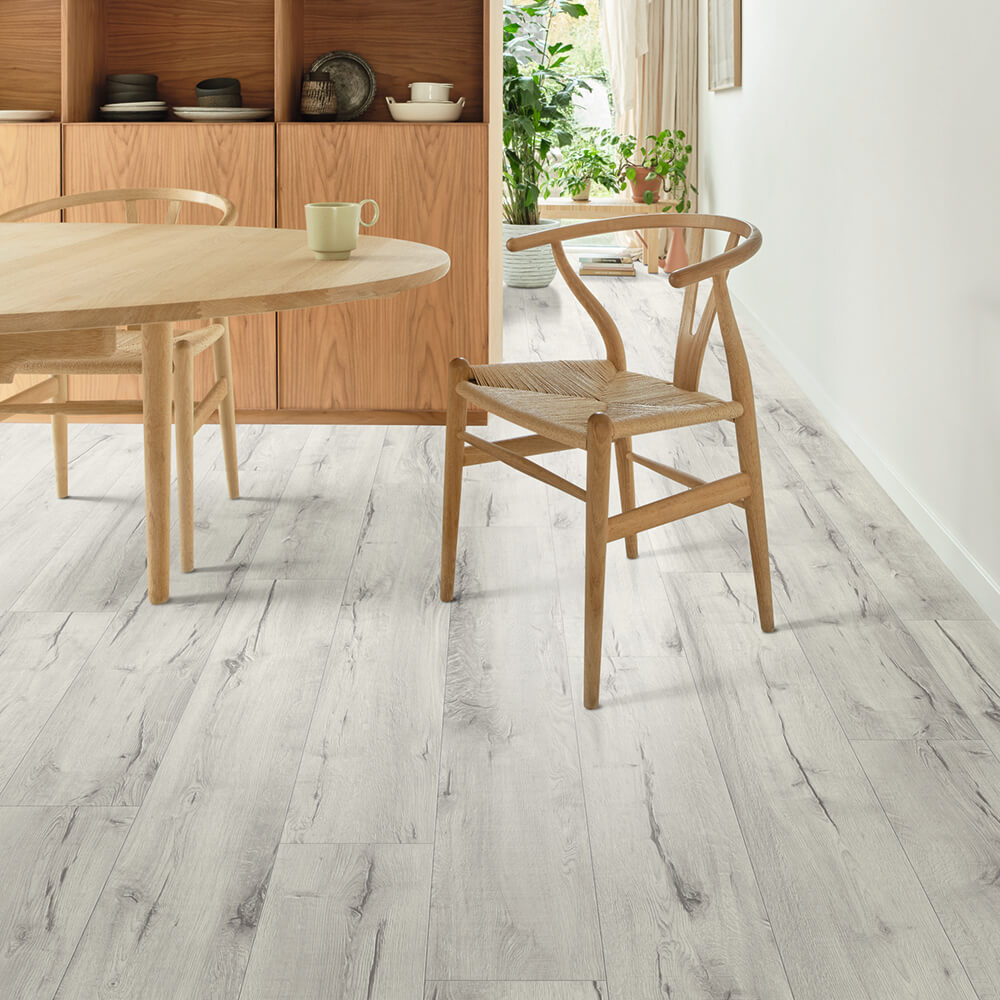Why Choose Luxury Vinyl Flooring for Your Kitchen?
Luxury vinyl flooring (LVF) has become one of the top choices for kitchen flooring, offering homeowners a blend of style, durability, and affordability. With advances in manufacturing, LVF now comes in a variety of styles that mimic high-end materials like wood and stone, making it a versatile option for any kitchen design. Whether you’re remodeling your kitchen or building from scratch, luxury vinyl flooring could be the perfect solution.
- Affordability: One of the biggest reasons homeowners choose luxury vinyl flooring for their kitchens is its cost-effectiveness. While traditional materials like hardwood or ceramic tile can be expensive, LVF provides a similar look and feel at a fraction of the price. This makes it a great option for those looking to achieve a high-end aesthetic on a budget.
- Easy Installation: LVF is also popular due to its relatively simple installation process. Many homeowners can tackle installation as a DIY project, thanks to click-and-lock systems or peel-and-stick formats. This not only saves on labor costs but also allows for faster installation compared to materials like tile, which require grout and mortar.
- Comfort Underfoot: Unlike harder surfaces like tile or stone, luxury vinyl flooring offers a bit of cushioning underfoot. This is particularly beneficial in kitchens where you’re likely to spend long periods standing while cooking or cleaning. The softer surface is more forgiving on joints and can even help reduce fatigue.
- Water Resistance: Kitchens are prone to spills, splashes, and humidity, and luxury vinyl is well-suited to handle these conditions. LVF is designed to be water-resistant or even fully waterproof, making it a better choice than hardwood, which can warp or stain when exposed to moisture.
- Variety of Styles: With a wide range of colors, patterns, and textures, LVF can mimic more expensive flooring materials like hardwood, ceramic, and natural stone. This gives you the freedom to choose a design that complements your kitchen décor without compromising on the performance.
- Low Maintenance: Luxury vinyl flooring is incredibly easy to care for, requiring only basic cleaning with a broom or mop to keep it looking pristine. This makes it an ideal choice for busy kitchens, where ease of maintenance is just as important as aesthetics.

Durability and Water Resistance: Key Features for Kitchens
Kitchens are among the most demanding rooms in a home, and the flooring you choose needs to withstand the wear and tear of daily life. Durability and water resistance are two of the most important features to consider when selecting flooring for your kitchen. Luckily, luxury vinyl flooring excels in both areas, making it an excellent choice for this high-traffic room.
Durable Construction: Luxury vinyl flooring is made from multiple layers, including a wear layer that protects the surface from scratches, dents, and stains. This makes it highly resistant to the kinds of damage that can occur in a kitchen, whether it’s from heavy foot traffic, moving appliances, or the occasional dropped item.
Scratch and Dent Resistance: The top wear layer of luxury vinyl is designed to withstand scratches and dents, which is particularly important in kitchens where chairs, stools, and other furniture are regularly moved. This feature helps LVF maintain its appearance longer than many other types of flooring.
Impact Resistance: Kitchens often see a lot of activity, from heavy pots and pans to small kitchen gadgets being dropped. LVF is designed to absorb impact better than materials like tile or hardwood, which can crack or dent under similar circumstances. The slight cushioning in luxury vinyl makes it more forgiving for accidents.
Waterproof and Water-Resistant Options: One of the standout features of luxury vinyl flooring is its water resistance. Many luxury vinyl products are 100% waterproof, meaning they can handle spills, splashes, and humidity without warping, swelling, or staining. This makes LVF a better option than traditional wood flooring for kitchens, where water exposure is common.
Resistant to Staining: In a busy kitchen, spills are inevitable. Fortunately, luxury vinyl flooring is resistant to staining, making it easy to clean up after spills. Liquids like wine, coffee, or oil that could permanently stain other flooring types can be wiped away from luxury vinyl with little to no lasting damage.
Long-Lasting Durability: With proper care and maintenance, luxury vinyl flooring can last for decades, even in high-traffic areas like the kitchen. Its durable construction makes it resistant to wear and tear, ensuring that it retains its beauty and functionality for years to come.
Design Options: Mimicking Wood, Stone, and More
One of the key reasons homeowners love luxury vinyl flooring is the wide range of design options available. LVF can mimic the look of almost any material, from classic hardwood to sleek stone. This versatility allows you to create the kitchen of your dreams without the high cost or maintenance associated with natural materials.
Wood-Look Luxury Vinyl: Many homeowners love the look of hardwood floors, but wood isn’t always practical for a kitchen. LVF offers a solution by mimicking a variety of wood species, from oak and maple to exotic woods like teak or mahogany. The realistic textures and grains in wood-look luxury vinyl make it hard to distinguish from real wood.
Stone-Look Luxury Vinyl: If you prefer a more modern or industrial aesthetic, stone-look luxury vinyl is a great option. This type of LVF can mimic natural stones like slate, marble, or travertine, offering the sophisticated look of stone without the cold surface or high price tag. It’s perfect for adding a touch of luxury to your kitchen.
Tile-Look Luxury Vinyl: LVF can also replicate the look of ceramic or porcelain tiles, giving you the ability to create intricate patterns, such as hexagons or herringbone designs. Unlike real tile, luxury vinyl is softer underfoot and doesn’t require grout, making it easier to install and maintain.
Variety of Colors: In addition to different textures and patterns, luxury vinyl flooring comes in a wide range of colors. Whether you prefer neutral shades like gray, beige, or brown or want to make a bold statement with vibrant hues, there’s a luxury vinyl option to match your vision.
Realistic Textures: Modern LVF not only look like natural materials, but it also feels like them. Advanced manufacturing techniques allow luxury vinyl to mimic the texture of real wood grain or the uneven surface of natural stone. This adds to the overall realism and creates a tactile experience similar to the real thing.
Customizable Patterns: With luxury vinyl flooring, you can get creative with your kitchen design. Many homeowners choose to mix and match different patterns or colors to create a unique look. Whether it’s a checkerboard pattern, a mosaic, or a herringbone layout, LVF gives you the flexibility to design a floor that suits your personal style.
How to Install Luxury Vinyl Flooring in Your Kitchen
Installing luxury vinyl flooring in your kitchen is a relatively straightforward process that can be completed by most DIY enthusiasts. With the right tools and a step-by-step approach, you can achieve professional-looking results. Here’s how to install LVF in your kitchen.
Prepare the Subfloor: The first step in installing luxury vinyl flooring is to ensure that the subfloor is clean, dry, and level. Remove any existing flooring, clean the surface thoroughly, and patch any holes or uneven spots. LVF can be installed over various subfloors, including concrete, plywood, or even existing vinyl, as long as the surface is smooth.
Measure and Plan the Layout: Before you begin laying the flooring, measure your kitchen space to determine how much material you’ll need. It’s also a good idea to plan the layout ahead of time. Consider where to start, especially in areas where you want the pattern to align perfectly, such as at the entrance or along cabinet edges.
Acclimate the Vinyl Flooring: Before installation, let the vinyl planks or tiles acclimate to the room’s temperature for at least 24-48 hours. This step ensures that the material doesn’t expand or contract after it’s installed, preventing gaps or buckling later on.
Start Laying the Floor: Depending on the type of luxury vinyl flooring you’re using (planks or tiles), you can either use a click-and-lock system or adhesive. If you’re using planks with a floating floor system, simply snap the edges together, working your way from one side of the room to the other. If using adhesive-backed tiles, carefully press them into place, ensuring proper alignment.
Cutting Around Obstacles: Kitchens often have obstacles like cabinets, islands, and appliances that you’ll need to work around. Use a utility knife or a vinyl cutter to trim the planks or tiles to fit snugly around these features. Make sure your cuts are precise to avoid gaps.
Finishing Touches: Once the floor is installed, add baseboards or quarter-round molding to cover the edges where the flooring meets the walls. This will give your kitchen a finished look. If you’re using floating vinyl flooring, allow the floor to “float” freely by leaving a small gap between the edges and the walls for expansion and contraction.
Cost Comparison: Luxury Vinyl Flooring vs. Other Kitchen Flooring Options
When it comes to kitchen flooring, homeowners have plenty of options, from traditional hardwood to ceramic tile to laminate. However, luxury vinyl flooring stands out for its affordability, especially when compared to more expensive materials. Let’s break down the cost comparison between LVF and other popular kitchen flooring options.
Luxury Vinyl Flooring (LVF): The cost of luxury vinyl flooring typically ranges from $2 to $7 per square foot, depending on the quality and style you choose. Installation is also relatively affordable, especially if you opt for a DIY approach. Overall, LVF is one of the most budget-friendly options available, offering great value for its durability and design versatility.
Hardwood Flooring: Hardwood floors are a classic choice for kitchens, but they come with a hefty price tag. On average, hardwood costs between $8 and $15 per square foot, and installation adds significantly to the cost. While hardwood is beautiful and long-lasting, it’s not the best choice for kitchens due to its susceptibility to water damage.
Ceramic or Porcelain Tile: Tile flooring is another popular option for kitchens, with a price range of $5 to $10 per square foot. While tiles are durable and resistant to water, the cost of installation can be high, particularly if you hire a professional to lay the tiles and grout. Additionally, tiles can feel cold and hard underfoot, making them less comfortable for kitchen use.
Laminate Flooring: Laminate flooring is often considered an affordable alternative to hardwood, with prices ranging from $3 to $8 per square foot. While laminate can mimic the look of wood, it lacks the durability and water resistance of luxury vinyl. Laminate is prone to swelling when exposed to moisture, which can be problematic in a kitchen environment.
Engineered Wood Flooring: Engineered wood offers a similar appearance to solid hardwood but at a slightly lower price, usually ranging from $6 to $12 per square foot. While engineered wood is more resistant to moisture than solid wood, it still doesn’t offer the same level of water resistance as luxury vinyl, making it a less practical option for kitchens.
Overall Value: When considering both upfront costs and long-term durability, luxury vinyl flooring offers the best value for kitchens. It provides the look of high-end materials without the associated price tag, and its water-resistant properties make it well-suited to the kitchen’s unique demands.
Maintenance Tips for Keeping Your Kitchen Luxury Vinyl Flooring Looking New
Once your luxury vinyl flooring is installed, keeping it looking new is a breeze with proper maintenance. Regular cleaning and care will help extend the life of your floor and preserve its appearance. Here are some key tips for maintaining your kitchen luxury vinyl flooring.
Regular Sweeping and Vacuuming: Dirt, dust, and debris can accumulate on your floor and cause scratches if left unchecked. Regular sweeping or vacuuming (using a soft brush attachment) helps prevent dirt from building up. This is especially important in high-traffic areas like the kitchen, where food particles and crumbs are common.
Wipe Up Spills Promptly: One of the best features of luxury vinyl flooring is its water resistance, but it’s still a good idea to clean up spills as soon as they happen. Promptly wiping up liquids prevents any potential staining and keeps the surface in top condition.
Use a Damp Mop for Deeper Cleaning: For more thorough cleaning, use a damp mop with a mild, pH-neutral cleaner designed for vinyl flooring. Avoid using abrasive scrubbers or harsh chemicals, as they can damage the surface of the vinyl. Regular mopping will keep your floor looking fresh and free of grime.
Protect Against Furniture Scratches: Heavy furniture and appliances can leave marks on your luxury vinyl floor if not properly protected. Place felt pads under the legs of chairs, tables, and other furniture to prevent scratches and dents. For larger appliances, consider using furniture sliders when moving them to avoid gouging the floor.
Use Rugs and Mats in High-Traffic Areas: Placing rugs or mats in high-traffic areas, such as near the sink, stove, or entryways, can help protect your floor from excessive wear. Be sure to choose non-slip rugs with backing that won’t discolor or damage the vinyl surface.
Avoid Sharp Objects and High Heels: Sharp objects like knives or broken glass can puncture the surface of vinyl flooring, so be careful when handling them. High heels can also cause indentations on the floor, so it’s best to avoid walking on the vinyl with stilettos or other pointed shoes.
Luxury Vinyl Plank in the Kitchen FERMA Flooring
Vinyl Flooring – The Home Depot
Vinyl Flooring Myths: Get the Facts from Our Experts – Flooring Inc
How to Install Luxury Vinyl Plank Flooring – Jenna Kate at Home
The Best Vinyl Plank Flooring for Your Home 2021 HGTV
Kitchen Flooring Ideas LVT Flooring Harvey Maria
LVT vs. LVP Flooring: Whatu0027s the Difference? Flooring America
Related Posts:










